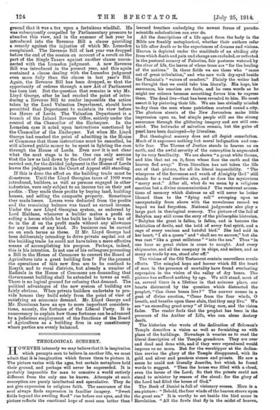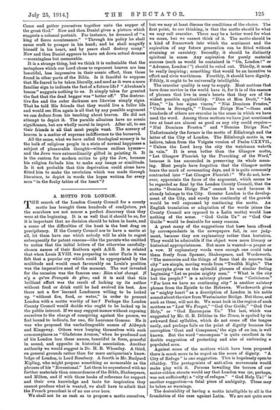THEOLOGICAL SCENERY.
HOWEVER intensely we may believe that it is inspiration which prompts men to believe in another life, we must admit that it is imagination which forces them to picture it. The picture varies with the ages, but certain metaphors hold their ground, and perhaps will never be superseded. It is probably impossible for man to conceive a world entirely different from the only one he knows. Attempts at such conception are purely intellectual and speculative. They do not give expression to religions faith. The assurance of the soul always finds expression in familiar imagery. "Sweet fields beyond the swelling flood" rise before our eyes, and the picture reflects the emotional hope of most men better than
learned treatises embodying the newest forms of pseudo. scientific scholasticism can ever do.
All the descriptions of a life apart from the body ia the Bible are frankly metaphorical, whether their authors refer to life after death or to the experiences of dreams and visions. Heaven is depicted under the similitude of an abiding city from which death and pain and change are excluded, or reflected in the pastoral scenery of Palestine, fair pastures watered, by the river of life, the leaves of whose trees are "for the hearing of the nations." In these fields we see those who "came out of great tribulation," and who now walk dry-eyed beside the Psalmist's "waters of comfort." Plainly the writer had no thought that we could take him literally. Ilia hope, his assurance, his emotion are facts, and he uses words as he might use colours because something forces him to express them. The dead live—that has been revealed. to him. He mush assert it by picturing their life. We are less civically minded to-day than the men whose patriotism centred round a city. The glorious streets of the New Jerusalem make little impression upon us, but simple people still see the strong assurance through the glittering imagery and are atilt con- soled. The bulwarks of salvation remain, but the gates of pearl have been deetroyed—by literalism.
But theological scenery does not all depict consolation. Much of it expresses nothing but moral indignation and con- trite fear. The Throne of Justice stands in heaven as on earth, and the awful severity of the conception is augmented by its very familiarity. We are shown "a great white throne, and him that sat on it, from whose face the earth and the heaven fled away." Even literalism has not taken the life out of that picture, for all its literal impossibility. "The winepress of the fierceness and wrath of Almighty God" still stands for a real emotion also, and so does the mysterious "mercy seat." After all, what do we mean by a religions emotion but a divine communication ? The recurrent accusa- tions of memory which distress us all will never be better likened than to the "flying roll" swooping upon us unexpectedly from above with the unwelcome record we hoped we had forgotten. National judgments also play a large part in theological scenery. The picture of the fall of Babylon may still rouse the envy of the philosophic historian. "Babylon the great is fallen, is fallen, and is become the habitation of devils, and the hold of every foul spirit, and a cage of every unclean and hateful bird." She had said in her heart, "I sit a queen" and "shall see no sorrow," but she was cast "like a great millstone" "into the sea." Thus "in one hour so great riches is come to naught. And every shipmaster, and all the company in ships, and sailors, and as many as trade by sea, stood afar off."
The visions of the OM Testament contain marvellous scenic effects. The mingled hope and horror which fill the heart of man in the presence of mortality have found everlasting expression in the vision of the valley of dry bones. The picture has suffered nothing by age. We still stand, most of us, several times in a lifetime in that noisome place, our hearts distracted by the question which distracted the prophet, "Can these bones live ?" The answer comes in a gust of divine emotion, "Come from the four winds, 0 breath, and breathe upon these slain, that they may live." We see "an exceeding great army" of living men, and the vision fades. The reader feels that the prophet has been in the presence of the Author of Life, who can, alone destroy death.
T he historian who wrote of the dedication of Solomon's Temple describes a vision as well as furnishing us with plans of the buildings. Nowadays it. wearies us to read the literal description of the Temple grandeurs. They are over and dead and done with, and. if they were reproduced would impress us no more. But for the worshipper at the dedica- tion service the glory of the Temple disappeared,. with its gold and silver and precious stones and priests. He saw a scene he could not literally describe, but which he found words to suggest.. "Then the house was filled with a cloud, even the house of the Lord; So that the priests could noh stand to minister by reason of the cloud: for the glory of the Lord had filled the house of God."
The Book of Daniel is full of visionary scenes. Hera is a sea picture : "Behold, the four winds of the heaven strove upon the great sea." It is worthy to set beside the bird scene ht Revelation. "All the fowls that fly in the midst of heaven, Come and gather yourselves together unto the supper of the great God." Now and then Daniel gives a picture which suggests a colossal portrait. For instance, he dreamed of "a king of fierce countenance." "Through his policy he shall cause craft to prosper in his hand; and be shall magnify himself in his heart, and by peace shall destroy many." Now and then Daniel appears to have set down actual dreams —meaningless but memorable.
It is a strange thing, but we think it is undeniable that the metaphors which our Lord chose to represent heaven are less beautiful, less impressive in their scenic effect, than those found in other parts of the Bible. Is it fanciful to suppose that He feared to be taken literally, and used as it were a mere familiar sign to indicate the fact of a future life ? "Abraham's bosom" suggests nothing to us. It simply takes for granted the fact that the dead beggar was "better off." The destruc- tive fire and the outer darkness are likewise simply signs. That he told His friends that they would live a fuller life and would see Him again is all that by any possible argument we can deduce from his teaching about heaven. He did not attempt to depict it. The parable allusions have no scenic significance, but are wholly moral in import. After all, to see their friends is all that most people want, The scenery of heaven is a matter of supreme indifference to the bereaved.
All the same, what we have called theological scenery is to the bulk of religious people in a state of normal happiness a subject of pleasurable thought—witness endless hymns— and the Jews were extraordinarily gifted in painting it. It is the custom for modern critics to pity the Jew, because his religion forbade him to make any image or similitude. Is it not probable that this deprivation could alone have fitted him to make the revelation which was made through literature, to depict in words the hopes written for every man "in the fleshy tables of the heart "?







































 Previous page
Previous page